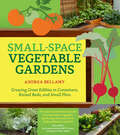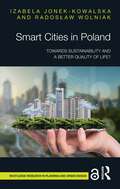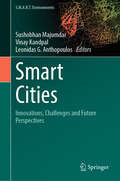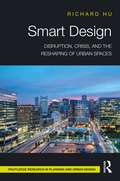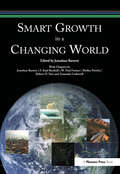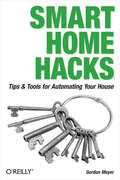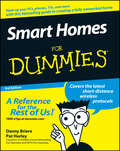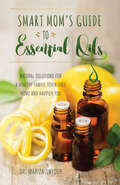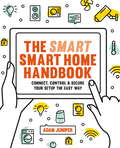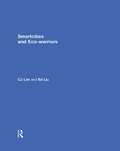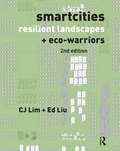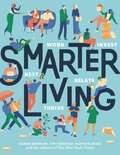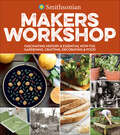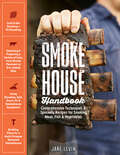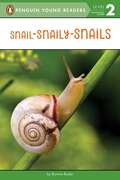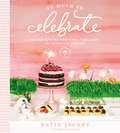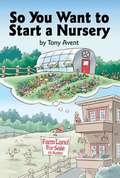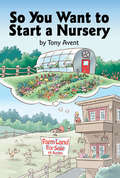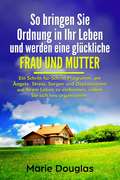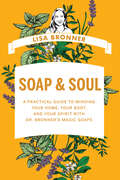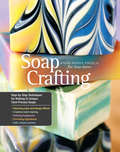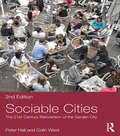- Table View
- List View
Small-Space Vegetable Gardens: Growing Great Edibles in Containers, Raised Beds, and Small Plots
by Andrea Bellamy“If I could recommend one book for small-space vegetable gardening, this would be it. Andrea Bellamy nailed it!” —Joe Lamp’l, Growing a Greener WorldSmall-Space Vegetable Gardens explains the basics of growing a bounty of edibles in a minimal amount of space. Andrea Bellamy, author of the award-winning blog Heavy Petal, shares all the knowledge she’s gained from years of gardening small: how to find and assess a space, and how to plan and build a garden. Bellamy also highlights the top sixty edible plants and offers complete information on how to sow, grow, and harvest them. This hardworking and enthusiastic guide teaches gardeners how to take advantage of the space they have—whether it’s a balcony, a patio, a plot in a community garden, or even a small yard—to create the food garden of their dreams.
Smart Cities in Poland: Towards sustainability and a better quality of life?
by Izabela Jonek-Kowalska Radosław WolniakThis book considers and examines the concept of a Smart City in the context of improving the quality of life and sustainable development in Central and Eastern European cities. The Smart City concept has been gaining popularity in recent years, with supporters considering it to be an effective tool to improve the quality of life of the city’s residents. In turn, opponents argue that it is a source of imbalance and claim that it escalates the problems of social and economic exclusion. This book, therefore, assesses the quality of life and its unsustainability in Central and Eastern European cities within the context of the Smart City concept and from the perspective of key areas of sustainable development. Using case studies of selected cities in Central and Eastern Europe and representative surveysof Polish cities, this book illustrates the process of creating smart cities and their impact on improving the quality of life of citizens. Specifically, this book investigates the conditions that a Smart City has to meet to become sustainable, how the Smart City concept can support the improvement of the residents’ quality of life and how Central and Eastern European countries create smartcity solutions. Containing both theoretical and practical content, this book will be of relevance to researchers and students interested in smart cities and urban planning, as well as city authorities and city stakeholders who are planning to implement the Smart City concept.
Smart Cities in Poland: Towards sustainability and a better quality of life? (Routledge Research in Planning and Urban Design)
by Izabela Jonek-Kowalska Radosław WolniakThis book considers and examines the concept of a Smart City in the context of improving the quality of life and sustainable development in Central and Eastern European cities.The Smart City concept has been gaining popularity in recent years, with supporters considering it to be an effective tool to improve the quality of life of the city’s residents. In turn, opponents argue that it is a source of imbalance and claim that it escalates the problems of social and economic exclusion. This book, therefore, assesses the quality of life and its unsustainability in Central and Eastern European cities within the context of the Smart City concept and from the perspective of key areas of sustainable development. Using case studies of selected cities in Central and Eastern Europe and representative surveysof Polish cities, this book illustrates the process of creating smart cities and their impact on improving the quality of life of citizens. Specifically, this book investigates the conditions that a Smart City has to meet to become sustainable, how the Smart City concept can support the improvement of the residents’ quality of life and how Central and Eastern European countries create smartcity solutions.Containing both theoretical and practical content, this book will be of relevance to researchers and students interested in smart cities and urban planning, as well as city authorities and city stakeholders who are planning to implement the Smart City concept.Chapter 2 and 6 of this book are freely available as a downloadable Open Access PDF at http://www.taylorfrancis.com under a Creative Commons Attribution-Non Commercial-No Derivatives (CC-BY-NC-ND) 4.0 license.
Smart Cities: Innovations, Challenges and Future Perspectives (S.M.A.R.T. Environments)
by Leonidas G. Anthopoulos Sushobhan Majumdar Vinay KandpalThis book aims to integrate new technologies and adaptation tools into the process of smart city planning. It also emphasizes the value and importance of modern technologies such as IoT and data science as a smart technology for the formation of a smart city. The authors believe that various technologies in a smart city will reduce all the problems for the sustainable growth and future prospects of the city. The first section of this book discusses the innovation of new technologies (AI, data science, block chain, etc.) that has flourished in recent decades which will make the city smarter. This section also describes that block chain and IoT (Internet of Things) are two transformative technologies that can greatly impact smart cities by enhancing security, improving transparency, and enabling efficient management of resources. The second section of the book explains about the uses of AI tools and smart technologies (like waste management, public safety and security) for the development and management of smart cities. This chapter also describes AI-powered systems that are integrated into smart buildings to optimize energy usage, enhance occupant comfort, and improve building management. These systems can adjust lighting and HVAC settings based on occupancy, learn user preferences, and provide personalized energy efficiency recommendations. The third portion of the book investigates the recent challenges and barriers of smart city that have been faced by the smart cities in the recent decades. This section also describes various challenges and barriers for the implementation of IoT sensor, AI technologies, etc., for the formation of a smart city. The future prospects of a smart city are the main theme of the last chapter. In this section, an attempt has been made about the future vision and outlook of the smart city. This chapter also describes different approaches (like smart grid, societal smart city, smart city model, etc.) for the future planning and management of the city.
Smart Design: Disruption, Crisis, and the Reshaping of Urban Spaces
by Richard HuThis book tackles the emerging smart urbanism to advance a new way of urban thinking and to explore a new design approach. It unravels several urban transformations in dualities: economic relationality and centrality, technological flattening and polarisation, and spatial division and fusion. These dualities are interdependent; concurrent, coexisting, and contradictory, they are jointly disrupting and reshaping many aspects of contemporary cities and spaces. The book draws on a suite of international studies, experiences, and observations, including case studies in Beijing, Singapore, and Boston, to reveal how these processes are impacting urban design, development, and policy approaches. The COVID-19 pandemic has accelerated many changes already in motion, and provides an extreme circumstance for reflecting on and imagining urban spaces. These analyses, thoughts, and visions inform an urban imaginary of smart design that incorporates change, flexibility, collaboration, and experimentation, which together forge a paradigm of urban thinking. This paradigm builds upon the modernist and postmodernist urban design traditions and extends them in new directions, responding to and anticipating a changing urban environment. The book proposes a smart design manifesto to stimulate thought, trigger debate, and, hopefully, influence a new generation of urban thinkers and smart designers. It will be of interest to scholars, students, and practitioners in the fields of urban design, planning, architecture, urban development, and urban studies.
Smart Growth in a Changing World
by Jonathan BarnettThis book is the latest book from the author, documents the United States' hidden crisis and shows how balanced transportation and natural resources preservation can make new urban development sustainable, as well as more efficient and more equitable.
Smart Home Hacks: Tips & Tools for Automating Your House
by Gordon MeyerSo much of what is commonplace today was once considered impossible, or at least wishful thinking. Laser beams in the operating room, cars with built-in guidance systems, cell phones with email access. There's just no getting around the fact that technology always has, and always will be, very cool.But technology isn't only cool; it's also very smart. That's why one of the hottest technological trends nowadays is the creation of smart homes.At an increasing rate, people are turning their homes into state-of-the-art machines, complete with more switches, sensors, and actuators than you can shake a stick at. Whether you want to equip your home with motion detectors for added security, install computer-controlled lights for optimum convenience, or even mount an in-home web cam or two purely for entertainment, the world is now your oyster. Ah, but like anything highly technical, creating a smart home is typically easier said than done.Thankfully, Smart Home Hacks takes the guesswork out of the process. Through a seemingly unending array of valuable tips, tools, and techniques, Smart Home Hacks explains in clear detail how to use Mac, Windows, or Linux to achieve the automated home of your dreams. In no time, you'll learn how to turn a loose collection of sensors and switches into a well-automated and well-functioning home no matter what your technical level may be.Smart Home Hacks covers a litany of stand-alone and integrated smart home solutions designed to enhance safety, comfort, and convenience in new and existing homes. Kitchens, bedrooms, home offices, living rooms, and even bathrooms are all candidates for smart automation and therefore are all addressed in Smart Home Hacks.Intelligently written by engineering guru and George Jetson wannabe, Gordon Meyer, Smart Home Hacks leaves no stone unturned. From what to purchase to how to use your remote control, it's the ultimate guide to understanding and implementing complete or partial home automation.
Smart Homes For Dummies
by Danny Briere HurleyDo you long to listen to your favorite CD from anywhere in your house? To set up a wireless network so you can access the Internet in any room? To install an iron-clad security system? To fire up the coffee pot while you're still asleep and wake up with automated lighting? Smart home technology can help you do just that!Smart Homes For Dummies, Third Edition, shows you how easy it can be to create and live in a cutting-edge, fully connected home--without breaking your bank account. With this user-friendly guide, you'll discover all the latest trends and gadgets in home networking, automation, and control that will help you make life more enjoyable and comfortable for your entire family. We help you plan for things such as flat-screen TVs, intercom systems, whole-home audio systems, gaming consoles, and satellite systems. We talk about your wiring (and wireless) options and introduce you to the latest technologies, such as VoIP and Bluetooth. You'll see how to:Build your home network on a budgetTurn your home into an entertainment centerAccess the Internet from any roomGet VoIP on your phone networkBoost in-home wireless and cell phone signalsConnect your computer to your TVSecure your home and propertyIncrease your home's resale valueAvoid common networking pitfallsAnd much, much moreComplete with a resource list for more information and neat toys of the future, Smart Homes For Dummies is your plain-English, twenty-first century guide to a fully wired home!
Smart Mom's Guide to Essential Oils: Natural Solutions for a Healthy Family, Toxin-Free Home and Happier You
by Mariza SnyderOffers over 50 of the most useful essential oil recipes for tackling every mom's daily needsAs a mother, you are always looking for ways to make your family safer, happier and healthier. This book shows how essential oils can help you achieve all those things. And you&’ll save money!An easy-to-use handbook for creating natural solutions, green cleaners, and toxin-free personal care items, the Smart Mom&’s Guide to Essential Oils provides pure and potent recipes, including:• Peppermint and Grapefruit energizing air diffusion• Fennel and Eucalyptus respiratory relief rub• Citrus-infused cleaning spray and scrub• Lavender and Melaleuca skin-soothing salve• Chamomile and Vetiver stress reliever• Spearmint-powered digestive aidYour family&’s wellness starts with you. That&’s why this helpful handbook also features a powerful regimen to reduce stress, increase energy and sustain your own personal vitality.
Smart Smart Home Handbook: Connect, control and secure your home the easy way
by Adam JuniperUntil just a few years ago, turning a light on and off with a clap was about as clever as technology got. Today, almost anything can be connected to the internet, and with this connection comes the ability to turn your bedroom lights off from another country, tell your thermostat to create a weather-appropriate lighting scheme, and answer the door without ever leaving your armchair.This book introduces you to Alexa, Siri, and every major technology competing to smarten your home and improve your life. You'll learn how to choose between them, how to optimize their function, and how to avoid the pitfalls that cause new adopters to wish they'd never let a computer into their home.
Smart Smart Home Handbook: Connect, control and secure your home the easy way
by Adam JuniperUntil just a few years ago, turning a light on and off with a clap was about as clever as technology got. Today, almost anything can be connected to the internet, and with this connection comes the ability to turn your bedroom lights off from another country, tell your thermostat to create a weather-appropriate lighting scheme, and answer the door without ever leaving your armchair.This book introduces you to Alexa, Siri, and every major technology competing to smarten your home and improve your life. You'll learn how to choose between them, how to optimize their function, and how to avoid the pitfalls that cause new adopters to wish they'd never let a computer into their home.
Smartcities and Eco-Warriors: The Ecological Landscapes For Urban Resilience
by Cj Lim Ed LiuModern methods of agriculture have led to cities growing out of control and reducing the available agricultural land, threatening the sustainability of our food system. The previous mutually sustaining relationships of animals, humans and the land have been lost with the progress of industry. The Smartcity – an ecological symbiosis between nature, society and the built form – is the innovative response to contemporary problems from one of the world’s leading urban design and architectural thinkers. Addressing the problems of unchecked city growth, the idea of the Smartcity questions whether we could begin to live once again from first principles, focusing in on the inhabitants of the city. The holistic construct of the Smartcity is developed through a series of international case studies, some commissioned by government organisations, others speculative and polemic. Reframing the way people think about urban green space and the evolution of cities, CJ Lim and Ed Liu explore how the reintegration of agriculture in urban environments can cultivate new spatial practices and social cohesion in addition to food for our tables. Representing an emerging architectural voice in matters of environmental and social sustainability, Smartcities and Eco-warriors is a long overdue treatment of the subject from a designer’s perspective, and is essential reading for practitioners and students in the fields of architecture, urban planning, environmental engineering, landscape design, agriculture and sociology. An inspiration to government agencies and NGOs dealing with climate change, it also resonates with anyone concerned about cities, energy conservation and the future of food
Smartcities, Resilient Landscapes and Eco-Warriors: Resilient Landscapes + Eco-warriors
by Ed Liu CJ LimFollowing on from the success of the first edition, Smartcities + Eco-Warriors (2010), this book is the latest innovative response on urban resilience from one of the world’s leading urban design and architectural thinkers. An ecological symbiosis between nature, society and the built form, the Smartcity cultivates new spatial practices and creates diverse forms of resilient landscapes including and beyond urban agriculture. The notion of the Smartcity is developed through a series of international case studies, some commissioned by government organisations, others speculative and polemic. This second edition has nine new case studies, and additional ecological sustainability studies covering sensitivity, design criteria, and assessments for ecological construction plans. The book concludes with two new essays on the romance of trees and the empowering nature of resilient landscapes. Smartcities, Resilient Landscapes + Eco-warriors represents a crucial voice in the discourse of climate change and the potential opportunities to improve the ecological function of existing habitats or create new landscapes which are considered beneficial to local ecology and resilience. It is indispensable reading for practitioners and students in the fields of landscape, urban design, architecture and environmental engineering. An inspiration to government agencies and NGOs dealing with sustainability, this work also resonates with anyone concerned about cities, landscapes, food and water security, and energy conservation.
Smarter Living: Work - Nest - Invest - Relate - Thrive
by Karen Barrow Tim Herrera Karron SkogSmart, actionable advice and life tips on how to improve your career, your home, your finances, your relationships, and your health for a happier life -- all from the popular Smarter Living section of the New York Times.Launched in the summer of 2016, the New York Times Smarter Living section was created with the mission to help readers live better lives by publishing stories that have fallen between the news desks. Since then, the section has produced more than 250 pieces offering useful advice on a wide range of topics -- including career and finance, love and relationships, health and wellness, and more -- that have been read by more than 22 million unique readers. Smarter Living collects these very popular pieces into one handy guide, creating a trusted source that will appeal to those just starting out as well those looking for new approaches to life's problems. The book identifies 5 key areas for building a better life: Work, Nest, Invest, Relate, and Thrive. Each area contains advice curated from the column on topics such as the Art of the Out of Office Reply, the Annual Home Checklist, What to Do When You're Bad at Money, How to Maintain Friendships, and How to Be Better About Stress. Each entry breaks down these sometimes overwhelming topics into manageable tasks through clear and concise guidance, easy-to-follow lists, and informative sidebars. Thoughtfully designed with bright, four-color illustrations similar to those found in the section, Smarter Living will be a perennial reference on how to create a healthy and happy life.
Smithsonian Makers Workshop: Fascinating History & Essential How-Tos: Gardening, Crafting, Decorating & Food
by Smithsonian Institution50 DIY crafts, cooking, decorating, and gardening projects from the experts at the Smithsonian Institution The Smithsonian Institution presents a uniquely curated collection of lively how-to projects and historical narratives of four realms of American domestic arts: cooking, crafts, decorating, and gardening. Perfect for hobbyists interested in the historical context of what they create for their homes, this beautifully illustrated book contains fifty DIY projects—from a uniquely American quilt pattern to on-trend crafts like terrarium making and pickling—that all offer satisfying ways to bring history and culture to life. For those craving more, features provide rare insights from Smithsonian experts on prominent figures, events, and trends. Readers can learn about influential Americans who've had an impact on each realm; look at visual timelines of significant events that pushed development forward; or stay in the present and see how American arts in contemporary life is being redefined, all while enjoying satisfying and unique projects.
Smokehouse Handbook: Comprehensive Techniques & Specialty Recipes for Smoking Meat, Fish & Vegetables
by Jake LevinFor backyard grilling enthusiasts, smoking has become an essential part of the repertoire. Butcher and charcuterie expert Jake Levin’s comprehensive guide, Smokehouse Handbook, guarantees mouthwatering results for producing everything from the perfect smoked salmon to a gorgeous smoked brisket. Levin demystifies the process of selecting the right combination of meat, temperature, and wood to achieve the ultimate flavor and texture. Detailed step-by-step photos show the various techniques, including cold smoking, hot smoking, and pit roasting. A survey of commercially available smokers critiques the features of each one, and for readers with a DIY bent, Levin includes plans and diagrams for building a multipurpose smokehouse. Featured recipes include specialty brines and rubs along with preparation guidelines for all the classic cuts of meat, including ham, brisket, ribs, bacon, and sausage, as well as fish and vegetables. With in-depth troubleshooting and safety guidelines, this is the one-stop reference for smoking success. This publication conforms to the EPUB Accessibility specification at WCAG 2.0 Level AA.
Snail-Snaily-Snails (Penguin Young Readers, Level 2)
by Bonnie BaderSnail-Snaily-Snails is a fun, informative book perfect for young readers!They're slimy, they're small, and they're slow. Some call them pests, and some call them a delicacy. What are they? Snails! Kids will learn all about these crawly creatures in this fact-and-photo-filled nonfiction reader.
So Much to Celebrate: Entertaining the Ones You Love the Whole Year Through
by Katie JacobsCreate meaningful, extraordinary celebrations and events that foster lifelong memories with the ones you love with inspiration from Katie Jacobs through her essential guide to entertaining.Create beautiful memories for your family and friends with help from Katie Jacobs, a stylist for Reese Witherspoon's lifestyle brand Draper James. She reveals her secrets for throwing fantastic parties for any occasion, from a casual backyard movie night to a lavish holiday party.The ultimate party hostess and styling pro, Katie shares her magical gift of making entertaining look effortless, and possible at the same time.Using Katie&’s inspiring ideas and make-ahead tips, you will be so organized that you can minimize the fuss, enjoy the time, and celebrate too!In So Much To Celebrate, readers will:Become inspired to make the most out of every season through entertaining loved ones Remind you to craft experiences for family and friends that can be felt (and tasted), not just seen Discover a mix of tasty recipes, creative entertainment tips, and a heavy helping of nostalgiaBrimming with creative party themes for every season, inspiring décor ideas, and delicious recipes, So Much to Celebrate is the perfect book for anyone who appreciates good times, good food, and good celebrations.
So You Want To Start A Nursery
by Tony AventWhen Avent announced that he was quitting his job to build a specialty nursery, his former horticulture professor begged his student to reconsider, telling him he couldn't possibly make a profit "without doing something illegal. " More than ten years and 20 nursery catalogs later, Avent owns a thriving national business with nearly 30 employees. He wrote So You Want to Start a Nursery to debunk myths about the ornamental-plants nursery business and what it takes to succeed, whether you're a backyard hobbyist or a wholesale grower. (And he still has a clean arrest record. ) Assuming that the reader has some basic knowledge about how plants are grown, Avent focuses on the business and planning concerns of the nursery owner. While recounting humorous stories of his baptism by fire as a beginning nurseryman, Avent also provides a primer on the nursery industry as a whole, with discussions of the merits and disadvantages of retail, wholesale, mail-order, and liner operations, to name just a few. Readers of this book will obtain the tools they need to make a business plan of their own. This book is a must-read for horticulture students, industry insiders, and advanced gardeners who dream of turning their passion for plants into a job they love.
So You Want to Start a Nursery
by Tony AventWhen Avent announced that he was quitting his job to build a specialty nursery, his former horticulture professor begged his student to reconsider, telling him he couldn't possibly make a profit "without doing something illegal." More than ten years and 20 nursery catalogs later, Avent owns a thriving national business with nearly 30 employees. He wrote So You Want to Start a Nursery to debunk myths about the ornamental-plants nursery business and what it takes to succeed, whether you're a backyard hobbyist or a wholesale grower. (And he still has a clean arrest record.) Assuming that the reader has some basic knowledge about how plants are grown, Avent focuses on the business and planning concerns of the nursery owner. While recounting humorous stories of his baptism by fire as a beginning nurseryman, Avent also provides a primer on the nursery industry as a whole, with discussions of the merits and disadvantages of retail, wholesale, mail-order, and liner operations, to name just a few. Readers of this book will obtain the tools they need to make a business plan of their own. This book is a must-read for horticulture students, industry insiders, and advanced gardeners who dream of turning their passion for plants into a job they love.
So bringen Sie Ordnung in Ihr Leben und werden eine glückliche Frau und Mutter: Ein Schritt-für-Schritt-Programm
by Marie DouglasDiese Buch handelt davon, wie Unordnung und schlechte Organisation unterbewusst Stress verursachen kann. Marie stellt unterschiedliche Strategien für einfaches und stressfreies Ausmisten und Organisieren vor. Ihre Schritt-für-Schritt-Anleitung wird Ihnen helfen, diese Sachen mit Freude zu erledigen und zu entspannen. Das Einzigartige an diesem Buch ist, dass es die wichtigsten und häufigsten Probleme, mit denen Hausfrauen, Mütter und Ehepartner sich herumschlagen, detailliert anspricht. In diesem Buch werden Sie auch viel Überraschendes finden.
Soap & Soul: A Practical Guide to Minding Your Home, Your Body, and Your Spirit with Dr. Bronner's Magic Soaps
by Lisa BronnerGoing Green blogger Lisa Bronner shares her eco-friendly, non-toxic solutions for cleaning and caring for body, home, and beyond. Clean body, clean home, clean spirit! This philosophy is the inspiration that Lisa Bronner—granddaughter of Dr. Emanuel Bronner—carries with her as a mother, homeowner, and company spokesperson for Dr. Bronner’s. Since the company was founded more than 75 years ago, it has been a trailblazer in the natural cleaning community thanks to its quality products and strong dedication to care for consumers and the planet. Now Soap & Soul imparts the secrets you’ll want for cleaning your home, body, and mind the Dr. Bronner’s way. For the reader learning how to go green as well as the loyal Dr. Bronner’s fans, this book is an invaluable resource. Lisa is at the ready to answer any question, from navigating labels and ingredients to understanding how your soaps and fabric softeners work. Organized by room and including charming line illustrations, this book is a recipe for a clean and happy home.
Soap Crafting: Step-by-Step Techniques for Making 31 Unique Cold-Process Soaps
by Anne-Marie FaiolaMake your own custom-tailored and perfectly formed cold-process soaps! Learn how to use milk jugs and yogurt containers for molds, and how coffee, avocado, and even beer can add unique dimensions to your creations. This encouraging introduction to the art of soapmaking makes it simple to master the techniques you need to safely and easily produce your own enticingly fragrant soaps.
Sociable Cities: The 21st-Century Reinvention of the Garden City (Planning, History and Environment Series)
by Colin Ward Peter HallPeter Hall and Colin Ward wrote Sociable Cities to celebrate the centenary of publication of Ebenezer Howard’s To-morrow: A Peaceful Path to Real Reform in 1998 – an event they then marked by co-editing (with Dennis Hardy) the magnificent annotated facsimile edition of Howard’s original, long lost and very scarce, in 2003. In this revised edition of Sociable Cities, sadly now without Colin Ward, Peter Hall writes: ‘the sixteen years separating the two editions of this book seem almost like geological time. Revisiting the 1998 edition is like going back deep into ancient history’. The glad confident morning following Tony Blair’s election has been followed by political disillusionment, the fiscal crash, widespread austerity and a marked anti-planning stance on the part of the Coalition government. But – closely following the argument of Good Cities, Better Lives: How Europe discovered the Lost Art of Urbanism (Routledge 2013), to which this book is designed as a companion – Hall argues that the central message is now even stronger: we need more planning, not less. And this planning needs to be driven by broad, high-level strategic visions – national, regional – of the kind of country we want to see. Above all, Hall shows in the concluding chapters, Britain’s escalating housing crisis can be resolved only by a massive programme of planned decentralization from London, at least equal in scale to the great Abercrombie plan seventy years ago. He sets out a picture of great new city clusters at the periphery of South East England, sustainably self-sufficient in their daily patterns of living and working, but linked to the capital by new high-speed rail services. This is a book that every planner, and every serious student of policy-making, will want to read. Published at a time when the political parties are preparing their policy manifestos, it is designed to make a major contribution to a major national debate.

